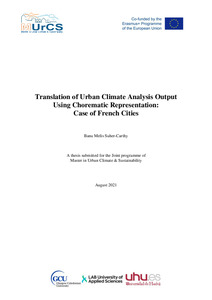Translation of urban climate analysis output using chorematic representation : case of French cities
Suher Carthy, Banu Melis (2021)
Suher Carthy, Banu Melis
2021
All rights reserved. This publication is copyrighted. You may download, display and print it for Your own personal use. Commercial use is prohibited.
Julkaisun pysyvä osoite on
https://urn.fi/URN:NBN:fi:amk-2021110119105
https://urn.fi/URN:NBN:fi:amk-2021110119105
Tiivistelmä
With the intention to support the integration of climatology into urban planning, this thesis explores an uncommon method for communication of microclimatic data to planners. The research aims to devise a methodology to conduct microclimatic analysis and deliver recommendations for 47 French cities. This approach builds on the chorematic representation technique as a form of graphic modelling that has been applied on Toulouse by the LISST Research Team. In this context, the urban climate data of 47 French cities is analysed with a focus on UHI effect.
Prior to the analysis of 47 cities’ UHI input, the MésoNH-SURFEX simulation data was investigated and pre-processed in R Statistical Software. To categorise cities on UHI intensities, the analysis was conducted with a perspective of spatial pattern and form. At this stage spatial metrics were used through patch analysis in ArcGIS. Following patch analysis, cluster analysis was performed for the partitioning of cases.
Four clusters were obtained with different UHI intensity characteristics: Cluster 1-Concentrated High Intensity, Cluster 2-Limited Intensity, Cluster 3-Dispersed High Intensity, and Cluster 4-Dispersed Cool Zones. Toulouse, situated within Cluster 1, was found to be compatible with the other cities in the cluster. Thus, the application of the Toulouse chorematic model for Cluster 1 was validated. The reproduction of chorematic representation for other clusters was demonstrated on Cluster 3 due to the high UHI intensity characteristics it held. For Metz, as the representative city of Cluster 3, UHI analysis and recommendations chorematic models were prepared.
The research showed that clustering method coupled with the spatial metrics yielded the desired outcomes in grouping of similar cases. While it is easier to reproduce graphic models for clusters with lower irregularities, clusters with higher complexities might require further focus on peculiarities. It is concluded that this workflow contributes to communicating the urban climatic information of multiple cities to planners through a holistic and time-efficient approach.
Prior to the analysis of 47 cities’ UHI input, the MésoNH-SURFEX simulation data was investigated and pre-processed in R Statistical Software. To categorise cities on UHI intensities, the analysis was conducted with a perspective of spatial pattern and form. At this stage spatial metrics were used through patch analysis in ArcGIS. Following patch analysis, cluster analysis was performed for the partitioning of cases.
Four clusters were obtained with different UHI intensity characteristics: Cluster 1-Concentrated High Intensity, Cluster 2-Limited Intensity, Cluster 3-Dispersed High Intensity, and Cluster 4-Dispersed Cool Zones. Toulouse, situated within Cluster 1, was found to be compatible with the other cities in the cluster. Thus, the application of the Toulouse chorematic model for Cluster 1 was validated. The reproduction of chorematic representation for other clusters was demonstrated on Cluster 3 due to the high UHI intensity characteristics it held. For Metz, as the representative city of Cluster 3, UHI analysis and recommendations chorematic models were prepared.
The research showed that clustering method coupled with the spatial metrics yielded the desired outcomes in grouping of similar cases. While it is easier to reproduce graphic models for clusters with lower irregularities, clusters with higher complexities might require further focus on peculiarities. It is concluded that this workflow contributes to communicating the urban climatic information of multiple cities to planners through a holistic and time-efficient approach.
